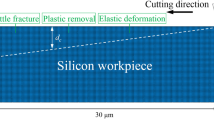Abstract
In this work, the ultimate compression force that enables the plastic removal of brittle materials in diamond turning is initially modeled according to the theory of rigid-plastic mechanics. And subsequently, an independent oscillator model is reconstructed to calculate the microfriction force that appears at contact interface. As expected, a predictive model considering the ultimate compression force and microfriction force is finally established to calculate the critical undeformed chip thickness of brittle materials in diamond turning, in which a crack-free surface of brittle materials can be achieved as quickly as possible in a brittle-ductile coupled cutting mode. Based on the theoretical predictions and experimental observations, the “size effect” of the critical undeformed chip thickness is discovered, i.e., that the ratio of the critical undeformed chip thickness to tool cutting edge radius increases with the decrement of tool cutting edge radius. Such interesting variation law is attributed to the strengthening of the effect of the microfriction and concentration of the compressive stress under a small enough cutting edge radius, which produces more favorable conditions for the brittle-ductile coupled removal of brittle materials.
Similar content being viewed by others
References
Ikawa N, Donaldson RR, Komanduri R, König W, McKeown PA, Moriwaki T, Stowers IF (1991) Ultraprecision metal cutting-the past, the present and the future. CIRP Ann Manuf Technol 40(2):587–594
Son SM, Lim HS, Ahn JH (2005) Effects of the friction coefficient on the minimum cutting thickness in micro cutting. Int J Mach Tool Manuf 45(4):529–535
Arif M, Zhang XQ, Rahman M, Kumar S (2013) A predictive model of the critical undeformed chip thickness for ductile–brittle transition in nano-machining of brittle materials. Int J Mach Tool Manuf 64:114–122
Dornfeld D, Min S, Takeuchi Y (2006) Recent advances in mechanical micromachining. CIRP Ann Manuf Technol 55(2):745–768
de Oliveira FB, Rodrigues AR, Coelho RT, de Souza AF (2015) Size effect and minimum chip thickness in micromilling. Int J Mach Tool Manuf 89:39–54
Woon KS, Rahman M (2010) The effect of tool edge radius on the chip formation behavior of tool-based micromachining. Int J Adv Manuf Technol 50(9–12):961–977
Liu K, Li XP, Rahman M, Neo KS, Liu XD (2007) A study of the effect of tool cutting edge radius on ductile cutting of silicon wafers. Int J Adv Manuf Technol 32(7–8):631–637
Yan J, Zhao H, Kuriyagawa T (2009) Effects of tool edge radius on ductile machining of silicon: an investigation by FEM. Semicond Sci Technol 24(7):075018
Arif M, Rahman M, San WY (2011) Analytical model to determine the critical feed per edge for ductile-brittle transition in milling process of brittle materials. Int J Mach Tool Manuf 51(3):170–181
Arif M, Rahman M, San WY (2012) Analytical model to determine the critical conditions for the modes of material removal in the milling process of brittle material. J Mater Process Technol 212(9):1925–1933
Chen HF, Zheng ZW, Dai YF, Gao H, Li XP (2010) Critical undeformed chip thickness and cutting pressure in relation to ductile mode cutting of KDP crystal. Key Eng Mater 443:582–587
Bifano TG, Dow T, Scattergood R (1991) Ductile-regime grinding: a new technology for machining brittle materials. J Manuf Sci Eng 113(2):184–189
Venkatachalam S, Li X, Liang SY (2009) Predictive modeling of transition undeformed chip thickness in ductile-regime micro-machining of single crystal brittle materials. J Mater Process Technol 209(7):3306–3319
Wang J-JJ, Liao YY (2008) Critical depth of cut and specific cutting energy of a microscribing process for hard and brittle materials. J Eng Mater Technol 130(1):011002
Cai M, Li X, Rahman M (2007) Study of the mechanism of nanoscale ductile mode cutting of silicon using molecular dynamics simulation. Int J Mach Tool Manuf 47(1):75–80
Arefin S, Li X, Rahman M, Liu K (2007) The upper bound of tool edge radius for nanoscale ductile mode cutting of silicon wafer. Int J Adv Manuf Technol 31(7–8):655–662
Zhang XQ, Arif M, Liu K, Kumar AS, Rahman M (2013) A model to predict the critical undeformed chip thickness in vibration-assisted machining of brittle materials. Int J Mach Tool Manuf 69:57–66
Sun YL, Zuo DW, Wang HY, Zhu YW, Li J (2011) Mechanism of brittle-ductile transition of a glass-ceramic rigid substrate. Int J Miner Metal Mater 18(2):229–233
Fang FZ, Wu H, Liu YC (2005) Modelling and experimental investigation on nanometric cutting of monocrystalline silicon. Int J Mach Tool Manuf 45(15):1681–1686
Xia ZG (2005) Plastic mechanics theory. Tongji University Press, Shanghai (in chinese)
Smith J, Perry T, Banerjea A, Ferrante J, Bozzolo G (1991) Equivalent-crystal theory of metal and semiconductor surfaces and defects. Phys Rev B 44(12):6444–6465
Ferrante J, Zypman FR (2006) Generalization of equivalent crystal theory to include angular dependence. Comput Mater Sci 36(4):425–431
Tomlinson GA (1929) CVI. A molecular theory of friction. Lon Edin Dub Phil Mag J Sci 7(46):905–939
Ding LY, Huang P (2010) Study of interfacial friction mechanism based on the coupled-oscillator model. Wear 268(1):172–177
Aghemenloh E, Idiodi JOA, Azi SO (2009) Surface energies of hcp metals using equivalent crystal theory. Comput Mater Sci 46(2):524–530
Ren F, Cao K, Ren J, Volinsky AA, Tran TH, Tian B (2014) Numerical calculation of the electron density at the Wigner–Seitz radius based on the thomas-fermi-dirac equation. J Comput Theor Nanosci 11(2):344–347
Cheng X, Wei XT, Yang XH, Guo YB (2014) Unified criterion for brittle–ductile transition in mechanical microcutting of brittle materials. J Manuf Sci Eng 136(5):051013
Zong WJ, Li ZQ, Sun T, Cheng K, Li D, Dong S (2010) The basic issues in design and fabrication of diamond-cutting tools for ultra-precision and nanometric machining. Int J Mach Tool Manuf 50(4):411–419
Yu HZ (2007) Infrared optical materials. National Defense Industry Press, Beijing (in chinese)
Zong WJ, Huang YH, Zhang YL, Sun T (2014) Conservation law of surface roughness in single point diamond turning. Int J Mach Tool Manuf 84:58–63
Author information
Authors and Affiliations
Corresponding author
Rights and permissions
About this article
Cite this article
Zong, W.J., Cao, Z.M., He, C.L. et al. Critical undeformed chip thickness of brittle materials in single point diamond turning. Int J Adv Manuf Technol 81, 975–984 (2015). https://doi.org/10.1007/s00170-015-7264-2
Received:
Accepted:
Published:
Issue Date:
DOI: https://doi.org/10.1007/s00170-015-7264-2




